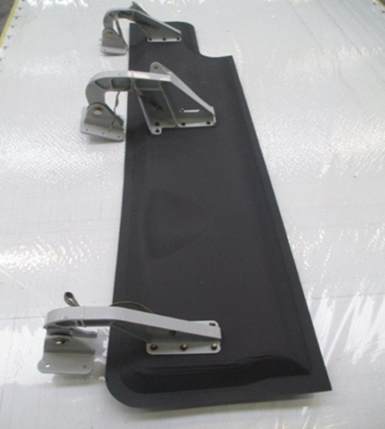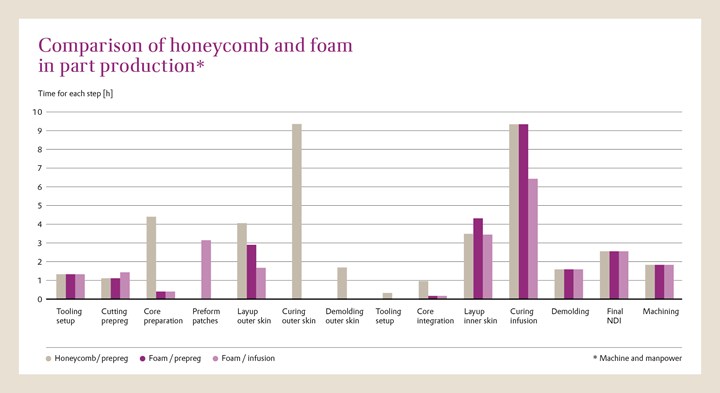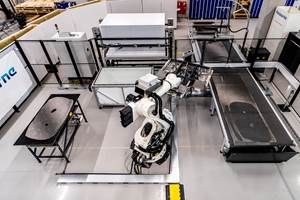
Dornier 728 nose landing gear door. Source | Evonik
The aircraft industry uses carbon fiber/epoxy prepreg and honeycomb core for a variety of complex structural parts, such as wing access panels; wing flap track and fuselage belly fairings; leading and trailing edge parts; and spoilers, ailerons, winglets and landing gear doors.
However, according to Evonik Resource Efficiency GmbH (Essen, Germany), production of these parts cannot keep pace with market demand from aircraft OEMs seek to ramp up production rates. The problem is two-fold: time-intensive hand layup processes, and production bottlenecks inherent to the use of traditional honeycomb core for sandwich composites.
The open-cell structure of honeycomb core necessitates the use of potting materials to seal core edges, and requires the application of an adhesive film to bond the core material to the laminate skins. A time-consuming two-step curing process is also required to mold a honeycomb cored laminate.
As a solution, Evonik has been working with technology partners to study the feasibility of high-rate production of structural aircraft sandwich components using automated fiber placement (AFP) and automated tape laying (ATL) processes, and Evonik’s ROHACELL HERO polymethacrylimide (PMI) structural foam as an alternative to honeycomb core.
ROHACELL HERO is a rigid, closed-cell, structural foam core material first introduced in 2013, and certain grades are now Airbus AIMS (Airbus Industries Material Specification) 04-11-011 qualified flight approved as a core material. ROHACELL HERO’s high compressive strength, Evonik says, enables the material to cope with compaction during handling by vacuum robot arms; the closed-cell foam material also eliminates the additional molding and potting steps that cause process bottlenecks with honeycomb.
In a feasibility study completed in 2019, Evonik worked with Deutsche Zentrum fur Luft-und Raumfahrt e.V. (DLR, Stade, Germany), the national research center for aeronautics and space, along with Airbus subsidiary Composite Technology Centre GmbH (CTC, Stade), which specializes in composite processing technologies.

Source | Evonik
The study built on findings from a previous 2014 project from CTC, which studied material options for out-of-autoclave (OOA) hand lay-up production of a Dornier 728 nose landing gear door part, and found that Evonik’s PMI foam core sandwiched between carbon fiber/epoxy faceskins was 25% less expensive to produce and weighed 19% less than a carbon fiber/epoxy prepreg and honeycomb core design. The 2019 study set out to automate construction of the Dornier 728 part for high-volume production.
For the new study, carbon fiber/epoxy prepreg sandwich part preforming production trials were successfully carried out on DLR’s EVo plant, which is a highly flexible, fully automated production line. The EVo plant is fitted with conventional vacuum gripper robot arms for handling cut-to-size glass fiber and carbon fiber fabrics, tapes, lightning strike protection meshes and foam cores.
According to Evonik, the study results demonstrated 65% less mold tool utilization time compared to manual production of the same part. For aircraft part manufacturers, this effectively doubles production capacity, providing part output rates that Evonik says are unachievable with a honeycomb core using the same tooling. (See figure below).

Source | Evonik
The EVo plant robot lay-up trial demonstrated that it is possible to use automation to significantly reduce the overall production steps and time needed to manufacture the Dornier 728 nose landing gear door using ROHACELL HERO as the sandwich foam core material instead of an equivalent grade honeycomb core. An additional cost benefit was that EVo’s current automation equipment, which would have needed adaptations to handle a honeycomb core, did not need to be adapted to support the ROHACELL foam core part. Based on mechanical properties from the Fraunhofer IWM Institute in Halle, Germany, Evonik says that ROHACELL HERO also provides the same level of damage resistance and visual inspection detectability as an equivalent aircraft structural grade honeycomb core.
Evonik aims to take these processes and material to high-volume aircraft part production.
Related Content
McClarin Composites partners with ExxonMobil to accelerate high-speed RTM
Multimillion-dollar investment to drive next-gen automated RTM technology will open new applications and markets for composites OEMs.
Read MoreAirbus selects Airborne to supply automated ply placement system
The pick-and-place system with software-driven automated will be the first in Airbus facilities, enabling highly efficient and flexible dry fiber preform manufacture for A350 structures.
Read MoreMold 3D printing helps automate composite bathtub, shower production
As part of its efforts to automate as much of its production process as it can, Lyons Industries acquired a Massivit 10000 additive manufacturing system to quickly produce high-performance molds and support fixtures.
Read MoreOptimizing robotic winding of composite tanks and pipes
Pioneer in mandrel-based reinforced rubber and composite products, TANIQ offers TaniqWindPro software and robotic winding expertise for composite pressure vessels and more.
Read MoreRead Next
Developing bonded composite repair for ships, offshore units
Bureau Veritas and industry partners issue guidelines and pave the way for certification via StrengthBond Offshore project.
Read MorePlant tour: Daher Shap’in TechCenter and composites production plant, Saint-Aignan-de-Grandlieu, France
Co-located R&D and production advance OOA thermosets, thermoplastics, welding, recycling and digital technologies for faster processing and certification of lighter, more sustainable composites.
Read More“Structured air” TPS safeguards composite structures
Powered by an 85% air/15% pure polyimide aerogel, Blueshift’s novel material system protects structures during transient thermal events from -200°C to beyond 2400°C for rockets, battery boxes and more.
Read More

.jpg;width=70;height=70;mode=crop)





















